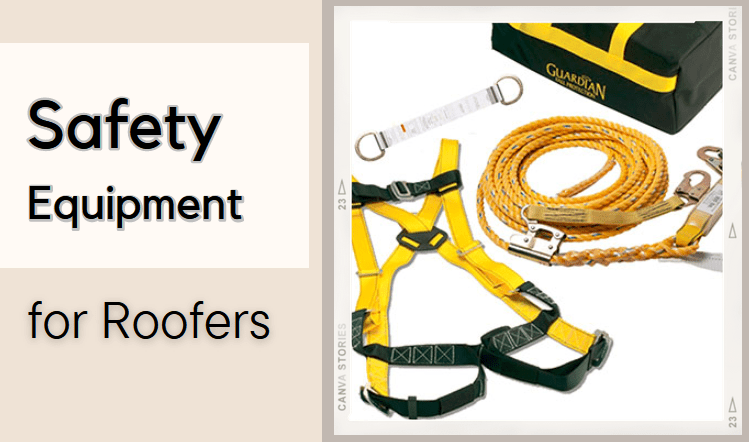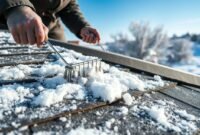Roofing is a high-risk profession, requiring strict adherence to safety protocols and utilization of specialized equipment to prevent accidents. Working at heights poses inherent dangers, including the risk of falls, slips, and injuries from falling debris.
To mitigate these risks, roofers must prioritize safety at every stage of their work. This includes comprehensive training on properly using safety equipment, such as harnesses, fall protection systems, and personal protective gear.
Essential Safety Equipment for Roofers
Roofing equipment serves to mitigate common workplace hazards. Key equipment includes:
● Fall Protection Systems
Working at significant heights, roofers face a unique set of challenges. Among these, the risk of falls ranks as the most severe, making fall protection systems an indispensable part of a roofer’s arsenal.
These systems consist of body harnesses, anchor points, and lifelines, each meticulously designed to arrest a fall swiftly and significantly limit the potential for injury.

● Protective Clothing and Gear
The protective measures extend beyond fall systems. Protective clothing and gear, such as helmets, sturdy roof safety shoes, and gloves, form an essential layer of defense.
Helmets shield roofers from falling debris that could cause head injuries, while sturdy footwear provides traction on sloping surfaces, reducing the likelihood of slips. Gloves, on the other hand, ensure an enhanced grip and protect hands from cuts and abrasions.
● Specialized Roofing Tools
The right tools make a significant difference. Specialized roofing tools, like roofing nail guns and shingle removers, can boost productivity while reducing manual handling risks. They offer a safer and more efficient way to perform tasks when used correctly.
How to Safeguard Yourself During Roof Work?
Maintaining safety during roof work involves several factors:
● Proper Setup
Safety during roof work extends beyond the use of a roof safety kit. An essential aspect is the correct setup of the work area. Roof brackets can provide stable platforms, decreasing the risk of slips and fall. Similarly, ladders should be positioned and secured correctly to prevent tipping or sliding.
Read also: How to Prevent Snow from Sliding Off Metal Roof Appropriately?
● Equipment Maintenance
Maintenance of tools and equipment also plays a crucial role in safety. Regular inspections can identify potential issues early, preventing accidents caused by faulty equipment. This includes checking for signs of wear and tear, ensuring proper functioning, and timely replacement of defective tools.
● Safe Work Procedures
Following safe work procedures is fundamental to maintaining safety. This includes keeping the workspace clean, using debris management equipment to avoid trips and falls, and following best practices in handling tools and materials.
Industry Regulations and Compliance
Compliance with industry regulations forms a cornerstone of safety in roofing. Authorities like OSHA have established comprehensive guidelines to protect workers from job-related hazards. These guidelines detail the use of safety equipment, installing and maintaining fall protection systems, and safe work practices.
Regular audits and inspections are crucial in ensuring adherence to these guidelines. They help identify areas of non-compliance and provide opportunities for improvement. Regular audits foster a safety culture within the industry, with organizations striving to stay compliant and improve safety records.
Training and Education for Proper Equipment Usage
Without proper training and education, even the best safety equipment can fall short in its purpose. Roofers should be adequately trained to use, inspect, and maintain their equipment. Training should cover aspects like adjusting harnesses, correctly attaching to anchor points and testing lifelines.
Read also: Best Roofing Fall Protection That Will Save Your Worker’s Life
In addition to equipment training, roofers should learn to recognize potential hazards and adopt safe work practices. This training should cover various scenarios, from identifying unstable structures to handling adverse weather conditions. The more aware roofers are of potential risks, the better prepared they will be to avoid accidents.
Safety equipment for roofers, adherence to regulations, and thorough training are the three pillars of safety in the roofing industry. Equipping roofers with the right tools, guiding them to follow regulations, and prioritizing education and training can significantly reduce accidents, ensuring safe work at great heights.


